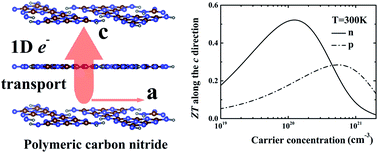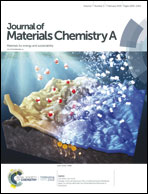Unexpectedly high cross-plane thermoelectric performance of layered carbon nitrides†
Abstract
Organic thermoelectric (TE) materials provide a brand new perspective to search for high-efficiency TE materials, due to their low thermal conductivity. The overlap of pz orbitals, commonly existing in organic π-stacking semiconductors, can potentially result in high electron mobility comparable to that of inorganic materials. Here we propose a strategy to utilize the overlap of pz orbitals to increase the TE efficiency of a layered polymeric carbon nitride (PCN). Through first-principles calculations and classical molecular dynamics simulations, we find that an A–A stacked PCN has unexpectedly high cross-plane ZT up to 0.52 at 300 K, and can contribute to n-type TE groups. The high ZT originates from its one-dimensional charge transport and low thermal conductivity. The thermal contribution of the overlap of pz orbitals is investigated, which slightly enhances the thermal transport when compared with that without considering the overlap effect. That is, there is a limited influence of orbital overlap to thermal conductivity. To explore the physical insight behind its TE advantages, we find that the low-dimensional charge transport results from strong pz-overlap interactions and the in-plane electron confinement, by comparing π-stacking carbon nitride derivatives and graphite. This study can provide guidance to search for layered materials with high cross-plane TE performance.

- This article is part of the themed collection: 2019 Journal of Materials Chemistry A HOT Papers


 Please wait while we load your content...
Please wait while we load your content...